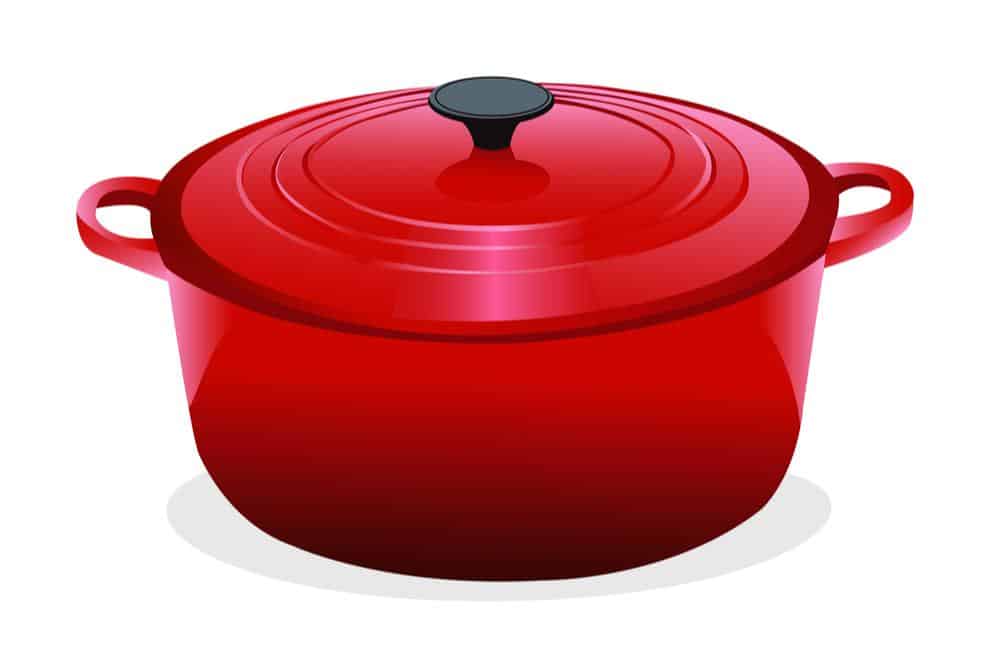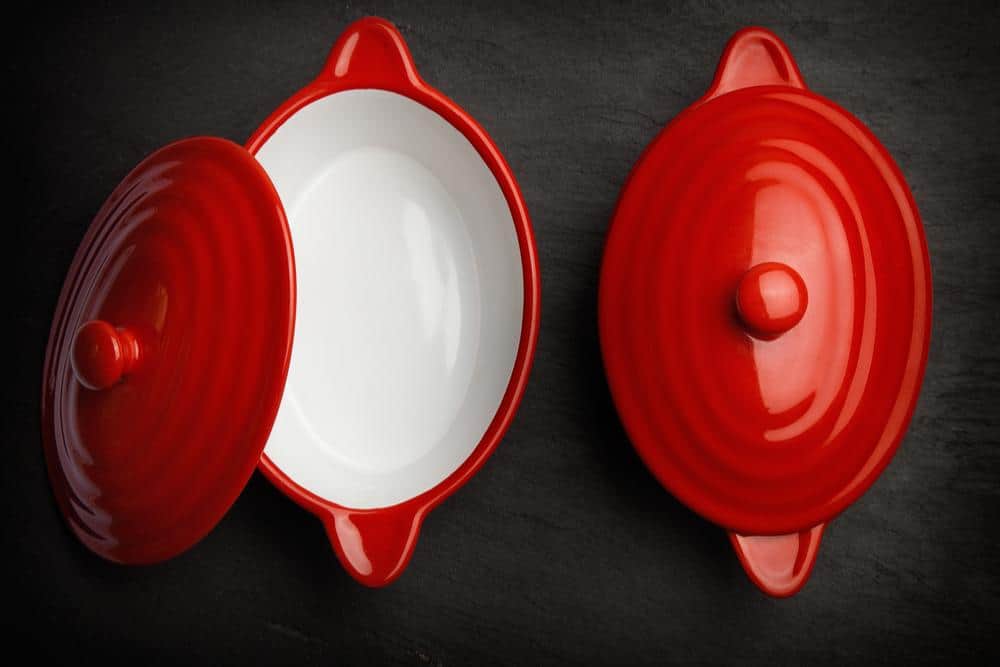If you make a visit to your local kitchen supply store, such as Williams Sonoma, you will see all the different dutch ovens you can get. You can choose between a Lodge dutch oven, Staub dutch oven, Le Creuset dutch oven, or several other brands.
Whatever type you get, the general composition is generally the same. Dutch ovens are manufactured as either non-enameled or enameled cast iron cookware. The porcelain enamel coating not only looks great, but it is also stain-resistant and easy to clean. These heavy pots are well suited for making everything from stews to bread. Cast Iron dutch ovens are a staple in many kitchens. Depending on the recipe, you may use your dutch oven on your stovetop or in the oven.
But can a Le Creuset lid go in the oven? While the bottom part of the cookware seems safe to put in your larger oven, you might find yourself scratching your head just before you're about to pop your Le Creuset dutch oven into your trusty kitchen oven.
It is an excellent question to ask in advance because it will ensure the best dutch oven experience, and you'll know how to take care of your stoneware. Read on to discover the versatility of your dutch oven and when to take extra precautions to protect the lid.
Le Creuset cookware, including Le Creuset stoneware and your Le Creuset dutch oven, is often an investment. As a result, it is understandable that you want to know how to provide fantastic care for these kitchen tools.
The large enameled cast iron pot part of the dutch oven is oven-safe, and the lid (also enameled cast iron) itself is oven-safe. Cast iron can actually withstand temperatures of over 500 degrees - which is around the maximum temperature stainless steel can withstand in an oven.
However, the knob on the lid can be temperature sensitive.
Depending on the exact collection of your dutch oven, the knob may be able to tolerate an oven temperature of 390 degrees Fahrenheit or a maximum high temperature of 500 degrees Fahrenheit.
There are many different varieties of Le Creuset Lids. Your Le Creuset lid can likely go in the oven to provide moisture and heat to your dutch oven creation. However, you must be conscious of the temperatures your Le Creuset lid knob can withstand.
Look up your particular model to find out how heat-resistant your model is. If you need a Le Creuset knob that can tolerate higher temperatures, simply consider searching for a different knob and screwing on a new one.
From Le Creuset’s official website, you can see that their glass lid with stainless steel knob is extremely heat resistant and able to withstand temperatures up to 425 degrees Fahrenheit.
In the video from Le Creuset showing the 7 ways to use your dutch oven, you can see that the entire dutch oven - including the lid and knob - is placed in the oven at the 44 second mark. They even show you how a dutch oven can be used for baking bread at the end of the video.
The 7 Ways to Use Your Le Creuset Dutch Oven from Their Official YouTube Channel
The Le Creuset knobs come in a few different versions. The black phenolic knob on the cast iron lid found on the Signature range of dutch ovens is heat-resistant up to 500 degrees Fahrenheit.

Meanwhile, the Classic range's black lid knobs of enameled cast iron pots can tolerate heat up to 390 degrees Fahrenheit.
Many recipes require you to put your dutch oven in the oven. Most of these recipes make that request, specifically so that the dish you are making can benefit from the enclosed space that a lidded dutch oven offers.
You can use a dutch oven in your large oven to make bread, stew, short ribs, coq au vin, macaroni and cheese, chicken dishes, and any other tender meat dishes. Most of these dishes benefit from the presence of a lid because the lid maintains the moisture in your dish.
Dishes usually benefit from the absence of a lid if you want to reduce the contents of the pot. In some cases, you may want to start with the lid on your dutch oven and remove it partway through.
As a result of this action, you will maintain the moisture of your dish while also allowing for browning.
It is safe to assume that all dutch ovens are oven-safe to 400 degrees Fahrenheit. This range is due to the qualities of cast iron. However, it is always good to check on your particular dutch oven.
You should also take note of the material of your knob. Some knobs are plastic, while others consist of metal. You can put the lid in the oven as long as you unscrew a plastic knob beforehand.
Some dutch ovens will list if they are oven-safe on the dutch oven itself or the pot's packaging. You may also be able to look up your specific model to determine if it is oven-safe.
Always pay attention to any specific temperatures mentioned since some pots and lids are oven-safe, but only up to a certain temperature.
For example, starting to bake a macaroni and cheese dish with a lid on will allow you to maintain a hydrated cheesy sauce, and then removing the lid part way through will help the macaroni and cheese develop a dark crust.
Cooking with the lid the entire time may lead to a moist cheese sauce but no crust. Cooking with the lid off the whole time can lead to brown but dry macaroni and cheese.
It is a good idea to preheat your dutch oven in many recipes. This action creates a warm environment for bread and other baked goods. It also ensures that you get even heat distribution and helps overall efficiency. These benefits can mean that your food is unlikely to stick unevenly.

If your dutch oven has enamel, it is essential that you only preheat your oven with some fat present. Otherwise, the enamel can become damaged. You should preheat your dutch oven for around 15 to 20 minutes.
In some cases, this length of time may need to be longer. For example, a recipe that requires a higher temperature or a deep-bottomed dutch oven may need to preheat longer.
However, when you place the pot portion of the dutch oven in the oven to preheat, it is not required to preheat the lid. The reason for this is that preheating the lid does not provide the benefits you are looking for. It also can make the lid more challenging to handle.
An occasional side effect of heating with the lid on is that pressure can build up inside the dutch oven. So, it can slightly explode when you remove the lid.
Instead, try only preheating the pot portion of the dutch oven and adding the lid when you add whatever you are cooking.
There are a few simple things that you can do to preserve the well-being of your dutch oven. Several problems can cause damage to the enamel of an enameled cast iron dutch oven. Excessive heat or metal tools can damage the enamel.
To prolong the life of your dutch oven, avoid cooking over high heat or using metal tools. Instead, use wooden or silicone tools. You should also avoid scrubbing the enamel with any abrasive material. If you need to get rid of stains, try boiling water and baking soda.
It is also best to avoid high heat, rapid changes in temperature, or having the pot heated without any contents. You should also only wash your dutch oven by hand. When cleaning it, always dry your dutch oven thoroughly and immediately after washing. A dishwasher may be too abrasive and hot for the health of your dutch oven's enamel.
If you do run into trouble with a knob that has been compromised by high heat, you can get ra eplacement knob online. Compatible knob types include both stainless steel knob and phenolic knob options.
